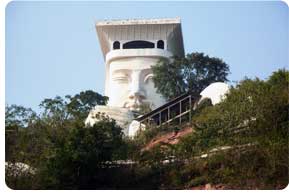 Fengdu Ghost City Fengdu Ghost City
丰都鬼城
Fengdu, located on the north bank of the Yangtze River and about 170km downstream from Chongqing, is an ancient city with a long history, known as the "Ghost City" to most Chinese people.
Fengdu got its reputation as the "Ghost City" in the Eastern Han Dynasty (A.D. 25 - A.D. 220) when Yin and Wang became Taoist recluses here. Both of them later became immortals by carrying out self-cultivation. Their names, when combined, mean "King of the Underworld." This story widely spread and the people began to call Fengdu the "Ghost City". Since Tang Dynasty, forty-eight temples have been built in this place, such as Temple of Heng and Ha, the "Hall of the Jade Emperor", " the "Palace of Hell", "Boundary Between the Living and the Dead", " the "Ridge of Helplessness" and the "Balcony of Nostalgia". All of the temples there look quite magnificent while statues are extremely lifelike.
The origin of the two vajras in the Temple of Heng and Ha can be traced back to ancient Indian Buddhism. They were transformed into two guardians with supernatural strength. Guardian Heng could roar or bellow a dazzling light and Han a yellow wind. A ghost who had misbehaved when alive would be knocked down by the light and wind, and prevented from entering the nether world.
The "Palace of Hell" was constructed on the Ming Hill by the river bank and many statues of ghosts and devils molded in the temples, these terrifying statues describe the after-life where people who disobey ancient Chinese morals are punished in every horrifying way. |



